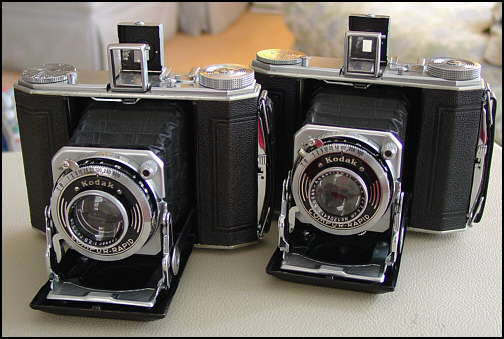
Kodak Duo Six-20
... photo samples
I've owned three of these cameras and now have two. This is the
Kodak/Nagel Duo Six-20 Series II The first had the Kodak Anastigmat lens.*
The second had a Tessar, so I sold the
first. The third, which I picked up recently, has the Kodak. I haven't had a
chance to use this camera.
Here are the cameras:

Tessar version is on the left, Kodak Anastigmat
is on the right.
Both cameras are identical in operation. They are scale focus cameras,
and both are marked in meters. When focusing, the entire lens/shutter
assembly moves in and out, much like the Retinas -- this is known as a
unit-focusing design. Front-cell focusing cameras only rotate the front
element within its helical. In theory, the unit-focusing design is better.
In practice, there are numerous front-cell cameras that produce excellent
results.
The focusing lever is the
small knob on the upper right of the lens board. The shutter release is in
the traditional spot on the top deck of the camera. I think the shutter
release travel is too long.
The button on the other side of the viewfinder is the release for the
lens door, which is heavily sprung. You should use your hand to slow it from slamming open. It's easy for
the camera to jump
out of your hands, if you're not paying attention.
The camera's accessory shoe is for a rangefinder. It's too small
to hold any type of flash unit, and even if it could fit, the viewfinder
might impede access to the shoe. The camera on the right is flash
synchronized. The one on the left isn't.
In any case, you'll need a bracket to attach a flash unit, if you happen
to have a flash-synchronized shutter.
As usual, each photo pops up to a larger version. If you're using a
pop-up stopper, you'll need to temporarily disable it.
Comments on the photos:
For some reason, any time that I used the Duo Six-20 in Hong Kong, it was always
an overcast day. So the lack of contrast has more to do with the weather
conditions than the lens. 1. This is a building called Times Square.
It's a modern-day shopping mall with some restaurants at the top. Very nice
place. The Kodak lens has done a good job at capturing detail. 2.
Alleyway in Wan Chai district. I think I was trying to use a hyperfocal
distance to get maximum depth of field. Didn't work too well, however, as
the further objects are rather soft. I think this one might be user error.
3. A school fair. I really blew the focus on this one. The kid on the
left was a neighbor of mine and would walk our dogs for my wife for a couple
of dollars each day. The woman in the center of the photo wearing the
striped shirt (no idea who she is) is sharply in focus. This is the only
shot on Tri-X. 4. This is Stanley Bay, or that's what I call it.
Shot at infinity, obviously. Again, the Kodak lens comes through. 5.
Shadows on the side of the house. From a couple of weeks ago on TMax
100. I was shooting at f/11. What looks like haze in the center of the photo
is really diffused light caused by the screen. Really. 6. Shadows on
the tree. Once again, to my dismay, the Tessar lens didn't do it. Maybe
I missed the focus again on this shot. Hard to tell. 7. Waiter, there's
a bug on my car! This shot didn't work, because I couldn't get close
enough to show the moth that's stuck to the front of the car. Even so, like
the others shot with the Tessar, there's an overall softness to the photo
that you don't see with the Kodak lens.
Conclusion
Using both cameras, I have to say the Kodak Anastigmat lens appears to be
sharper, judging the photos that I've taken with it. Neither lens had
cleaning marks, so that doesn't account for the difference. It pains me to
say this, but with this camera, the Kodak lens was simply a better
performer.
Perhaps the lens bed is out of parallel. I'm not sure. But it was clear
that the Duo Six-20 equipped with the Kodak-lens consistently gave me better
photos. And now some guy in San Diego owns it!
Update
I checked the lens on the camera with the Tessar and found that it hadn't
been collimated correctly. That was the primary factor in getting out-of-focus
shots. I recollimated the lens, and now it's as sharp as the Kodak lens.
Even so, the Kodak lens is an excellent performer, especially when you take
into account that it's a triplet.
* I had read
that the Kodak Anastigmat was a rebadged Schneider-Kreuznach Xenar. A recent
Internet discussion says the f/3.5 version of the Anastigmat is a
four-element Tessar type while the f/4.5 version is a triplet.
|